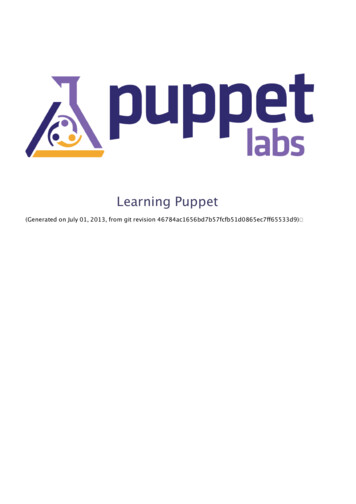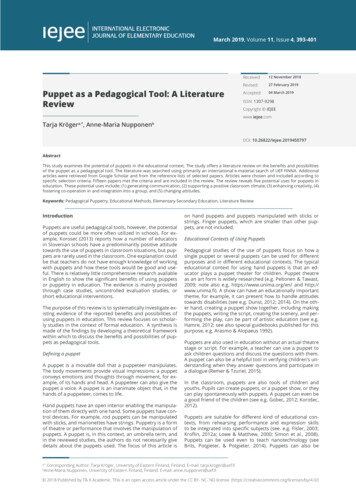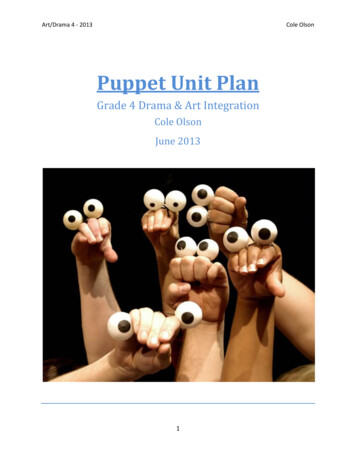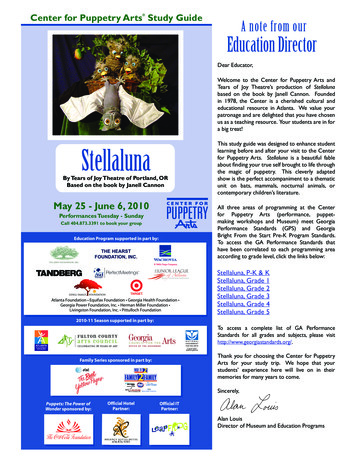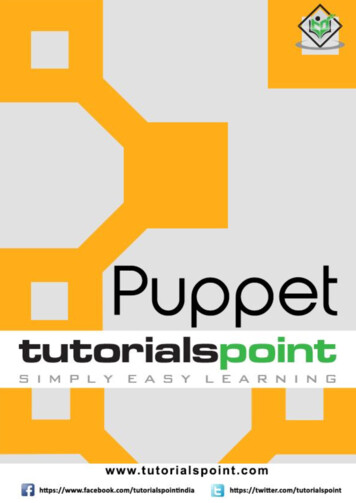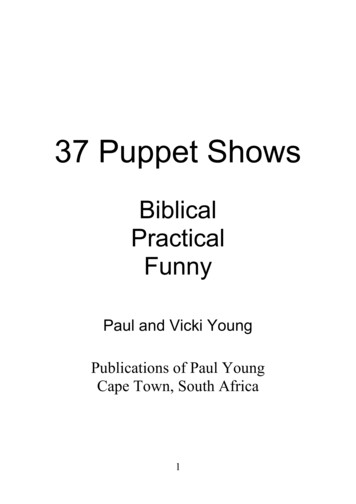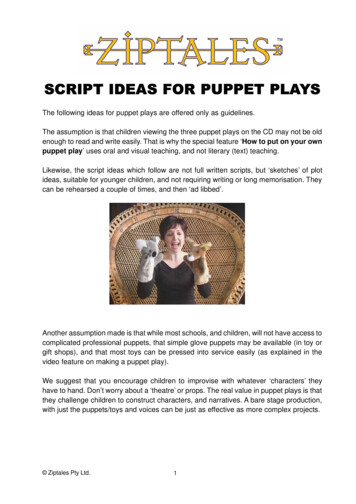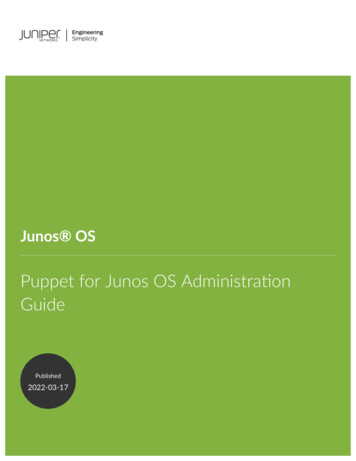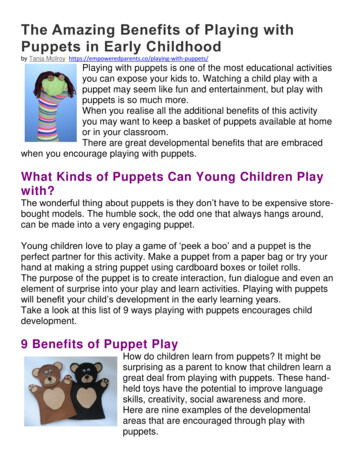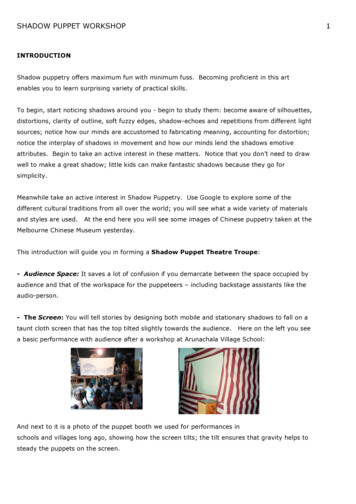
Transcription
SHADOW PUPPET WORKSHOP1INTRODUCTIONShadow puppetry offers maximum fun with minimum fuss. Becoming proficient in this artenables you to learn surprising variety of practical skills.To begin, start noticing shadows around you - begin to study them: become aware of silhouettes,distortions, clarity of outline, soft fuzzy edges, shadow-echoes and repetitions from different lightsources; notice how our minds are accustomed to fabricating meaning, accounting for distortion;notice the interplay of shadows in movement and how our minds lend the shadows emotiveattributes. Begin to take an active interest in these matters. Notice that you don’t need to drawwell to make a great shadow; little kids can make fantastic shadows because they go forsimplicity.Meanwhile take an active interest in Shadow Puppetry. Use Google to explore some of thedifferent cultural traditions from all over the world; you will see what a wide variety of materialsand styles are used.At the end here you will see some images of Chinese puppetry taken at theMelbourne Chinese Museum yesterday.This introduction will guide you in forming a Shadow Puppet Theatre Troupe:- Audience Space: It saves a lot of confusion if you demarcate between the space occupied byaudience and that of the workspace for the puppeteers – including backstage assistants like theaudio-person.- The Screen: You will tell stories by designing both mobile and stationary shadows to fall on ataunt cloth screen that has the top tilted slightly towards the audience.Here on the left you seea basic performance with audience after a workshop at Arunachala Village School:And next to it is a photo of the puppet booth we used for performances inschools and villages long ago, showing how the screen tilts; the tilt ensures that gravity helps tosteady the puppets on the screen.
SHADOW PUPPET WORKSHOPThe space of the screen can become multi-dimensional according to your imagination; for example ajeep on a journey can travel all the way around the circumference of the screen before reachingthe destination. Use your imagination.- Behind the Screen: The puppeteer WorkSpace - wherein no unauthorized person is allowed, isbehind the screen. Make it very comfortable there because this is where all the fun happensand learning to organize this space is an important task of a trainee puppeteer. The puppeteerswork behind the screen for shadows as you see here:This image was taken at a practice run at Somasapadi while below the images are behind thescreen action from performances at RishiValley Rural School; the projection from the secondimage can be seen from the audience perspective down below [the yellow blobs on that screenare probably turmeric splattered during the opening puja]:All the items required for projection, sound and light must have their own reliable place in thiswell-disciplined behind-the-screen space. Every puppeteer needs to be clear about her role andaltogether the puppeteers need to work as a functional co-operative troupe:2
SHADOW PUPPET WORKSHOP- In front of the screen: Here is a useful space between shadows and audience where glovepuppets can appear:This is the glove puppet Ratty introducing a show called The Rats in the Box. A person also mayappear here to introduce the show; use this space creatively.- Story, Script, Stage Plan, Storyboard:Consider some themes to begin. Consider different categories for performances: comic,suspenseful, exquisitely beautiful, local colour, social issues, dramatic action-packed, horror . . .Allocate groups to work on short sequences of story.Find stories that lend themselves to shadows, stories especially chosen for their illusory impact asshadow-play.A great deal of discussion and brain-storming is needed even before you begin tomake the puppets: you have to decide on your story, the characters, who will play them andwhat they will do. You need to be flexible - capable of spontaneous improvisation, but you alsoneed a very specific structure on which your story-telling relies.Of course you can also make up a show from a motley collection of old puppets – but you will stillneed time talking about the show imaginatively together as you see us doing below here atSomasapadi:3
SHADOW PUPPET WORKSHOPAs a group – a Troupe, we pool our ingenuity, imagination and practical skills.First find your story, and then think out together how you will tell your story and who will takewhat parts. You each need to imagine at every step together, each contributing. Puppet theatreforces us to solve all sorts of interesting, complex and unusual problems – as a group; it enablesus to become flexible in our search for solutions. Remember it is a democratic process. Noticethat the man in the yellow shirt above is part of a democratic decision-making process: he isrecording all the decisions, while the man in the red shirt is the Master Story-Teller cumPuppeteer providing extra oomph.When you have formed the structure on which to develop your presentation of the story youmight like to make a storyboard, sketching each scene to help you all envisage the performance.The structure is a preliminary framework on which to proceed: remember that this means oftelling a story is primarily visual, involving movement; audio effects and language substantiateand lend meaning content to your visual display; a sense of timing also contributes greatly toyour dramatic moments being most successfully presented. The atmosphere, setting, context anddialogue need to be economical. Go for simple, clear presentation. Think your story out in termsof succinct sections.Decide on dialogue, sounds, lights etc., everything. Each be able to improvise if the unexpectedhappens, but all should know what you are presenting at any stage, so work out well beforehandwho does what and when. Make up a list of actions connected with sound, light, entrances, exitsand so on. Allocate roles to different puppeteers.Make sure characters are well defined, easily recognizable and for the most part credible. Useincredible stuff sparingly. Develop the characters in terms of shape, movement, voice – reflectsomething immediately recognizable to your audience.The specific script frequently emerges as puppeteers play the story out on the screen and devisethe best means of conveying meaning, putting words in shadow’s mouths. Although Puppetry isprimarily a visual medium, nevertheless sounds – including words, give the story form and4
SHADOW PUPPET WORKSHOPcontribute meaning to the magic. Despite this, you can also make beautiful shadow puppet theatrewith no words at all.- The Puppeteer: Each puppeteer will become more and more versatile. We become more ableto get out of ourselves, capable of taking on different characters; we become good at makingfools of ourselves - easy to do behind the screen. Make sure you get some practice improvisingin case of necessity during a performance. A puppeteer is a specialized actor becoming proficientin many other capacities, especially coordinating with others in the troupe. We work out howbest to tell our stories by playing it in the most lively and coherent way. There will be someexamples of games what enhance group cohesion at the end here.- The Puppets:Recycled materials are used to make the puppets that will cast the shadows; interesting shapesare cut from cardboard and attached to thin rods made of broomsticks and/or umbrella spokes.Since the rods are so thin as to be almost invisible on screen [our minds are very good atignoring them] and puppeteers hold the puppets up between the light and the screen withoutheads and hands/arms intruding with their own shadows, the shadows of cardboard shapes willbecome our characters projected onto the screen.Consider all the different kinds of puppets, for example: single individual silhouettes – the simplerthe better [little kids make great simple outlines that work well], puppets with moving parts,composite puppets [like a football scrum or a bus with people in windows], object puppets thatmove [a swing for instance], background puppets [maybe a teashop].When designing a show, go for economy; don’t have too many props and never too manycharacters. Concentrate everything.Finally you come to making the puppets and playing with them to refine how they work.The simple mechanics are that puppets are held to the screen using thin rods [from coconut frondbroom or otherwise] taped inconspicuously to the puppet. Single silhouettes are put to life –animated - by movement of the puppeteer’s body. Music always enhances animation.A workshop first is to all make a single puppet and dance a parade across the screen, use music.All take notice of each other’s puppet. Then each put a few words in their puppet’s mouth, stopwhen you come to center screen one by one and give your voice. Practice different voices.Moving parts can be added using butterfly clips at joints and paper-clips cut in half and tapedinterlocking between rod and part. It can often take some time adjusting the moving parts untilthey are working perfectly, but notice that single silhouettes can manifest great characteraccording to the ingenuity of the puppeteer. Find out what your puppet can do, refine themovements so it does what you intend it to do, get to know precisely the way it works. Give it5
SHADOW PUPPET WORKSHOPsome other features: a hat, some hair, something silly and distinctive. Get to know its voice. Trysome gibberish.When you are all satisfied with the results make another multiply-moving-part-parade with Voice.Be flamboyant.Below here you see our work-table at Somasapadi with the puppeteers making their puppets alsowatching others working and refining theirs on the screen:The screen is where you make both your puppet and your story happen.- The Shadows: The puppeteer gives the shadows character by movement, voice and audioeffects; she uses her whole body to animate [that is: give life] to the shadow. First make andplay one single silhouette to make a character, get to know it before giving it moving parts likearms and legs, tools and equipment.You then practice moving the shadows about on the screenuntil you are satisfied with the result.Take a partner and make your two puppets interact, pair up for dialogues and altercations, twoby two practice an emphatic duo of rapscallion puppets, maybe you have a heated argument ingibberish; either speaking the same language or not. Decide together exactly what you two willsay and which movements accompany the voices, perfect your duo and then watch the results ofthe others in your troupe. Always go for simple, bold and clear exchanges, with economical useof movement coordinating intimately with the verbal.6
SHADOW PUPPET WORKSHOP- Sets and background: the ambience of our stories are created by mainly stationery puppetsmade of [lighter, thinner] cardboard that are pinned to the screen – these remain stationery asprops and are changed at ‘scene changes’ - blackouts. As a troupe you can build an archive ofprops to use on different occasions, ones that are pinned to the screen – Big Tree, TeaShop,Gopuram, Goat on rock, wickets etc., and you can also make props with rods like cricket bats,sleeping dogs, umbrellas, lines of water pots or people in a queue, woman sweeping, vehicles ofall kinds and so on. You can make props that do things and props that just stay put.- Entrances and Exits: Take particular notice of the entrances and exits – make themevocative, alluring, dramatic, sneaky or spooky or whatever. Pay attention to an arrestingbeginning, a lively middle and a memorable end – not necessarily in that order. Go for what issuccinct and meaningful, discard what’s unnecessary or indulgent.- Become conscious as a troupe about what sort of response you intend to achieve with yourperformance: some shows need to provoke the audience into reconsidering their perspective onlife, some to stir up wonder for the world, some to get them rolling with laughter. Some maydemand the audience ask questions.- Shadows can be combined with live theatre, persons dressed the part can represent shadowscoming out of the box behind the screen to interact with the audience. Audience interactionalways is a winner.- Choose an Overture to keep your audience happy while you set up and a Finale to play at thevery end. You can use taped music or cook up a band. Make it sparky.Materials and methods are very simple; our ingenuity is the ingredient for giving life to theshadows with the addition of the audio dimension.7
SHADOW PUPPET WORKSHOP8PRELIMINARIES:Now here are those warm-up exercises I mentioned:1.Form a circle of puppeteers.Allocate one to initiate the first sentence of a story: “Onceupon a time an old woman and her cat lived in the heart of a great forest . . . .” then thatperson says “Ga gong gong ga gong gong gong” and turns to the next person; one by onein turn each person contributes a sentence until the one before the first one has to findthe end. Then I suppose you all shout Ga gong gong ga gong gong gong.2.Form groups into huddles, each group devise sounds with your vocal chords for thesesituations:- the elements: wind, thunder, rain- transport: bus, scooter, bullock cart etc.- supernatural stuff: ghost or ghoul singing- forest sounds – wild animals etc.- make your own categoriesYou can also find sounds from objects around you.3.As one group all lie in corpse posture with eyes closed while one person makes a simpletapping sound; the others imagine these contexts to accompany the sound, in reality andin shadow play:- you are prisoners waiting news of your future- you’re refugees hiding in enemy territory- you are lost in a strange building searching for your torch in the dark.- make up your own here too.SHADOWS IN THE MELBOURNE CHINESE MUSEUM IN CHINATOWN AUSTRALIA:Yesterday we went in to see the exhibition of Shadow Puppets in the city so I took somephotographs for you. Like traditional Indian Shadow Puppets, the Chinese ones are veryelaborate, cut from fine leather and painted – very beautiful; a small screen showed a simple[elaborate] set with pavilion, tree and two puppets interacting:
SHADOW PUPPET WORKSHOPThere were materials laid out for children to make their own puppets:The museum forgot to provide a screen for kids so inevitably Hari and Ariyaa set themselves upon the beautiful Chinese screen and became engrossed in a SuperStory with very loud action:While Ani’s presentation was quiet and refined; Devi joined us from work and also had a go:9
SHADOW PUPPET WORKSHOP10Afterwards we walked down ChinaTown to a restaurant for dinner – it was cold and we were hungry:Ariyaa’s puppets continued to shout next to the Soy and Chilli sauce:
SHADOW PUPPET WORKSHOP 3 - In front of the screen: Here is a useful space between shadows and audience where glove puppets can appear: This is the glove puppet Ratty introducing a show called The Rats in the Box. A person also may appear here to introduce the show; use this s
